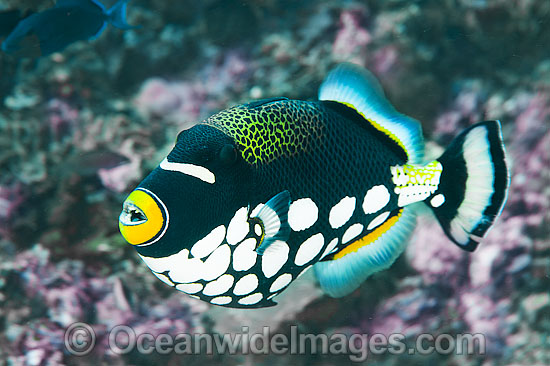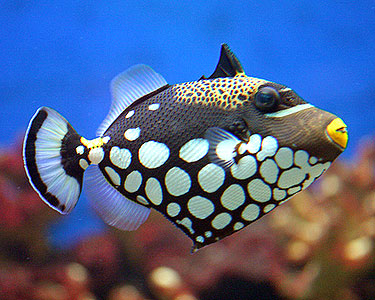
Balistoides conspicillum
FAMILY
Balistidae
TAXONOMY
Balistoides conspicillum Bloch and Schneider, 1801, Indian and
American seas.
OTHER COMMON NAMES
French: Baliste lйpreaux; German: Leoparden-Drьckerfisch;
Afrikaans: Nas-snellervis; Japanese: Mongarakawahagi.
PHYSICAL CHARACTERISTICS
Body and caudal peduncle are compressed; the body is robust
and oval in shape. There are three spines and 25–27 soft rays
in the dorsal fin as well as the anal fin. The first dorsal spine
can be locked into an erect position. The caudal fin is somewhat
rhomboid in shape. The body’s color pattern is unmistakable.
The background color is black, with large white spots
along the flank, a white breast and band below the eye, a
white caudal peduncle, and an alternating pattern of black,
white, and black on the caudal fin. The mouth is yellow or
orangish yellow, with a thin yellow stripe on a black background.
Faint yellow hues are found along the base of the anal
fin and on the caudal peduncle. The dorsal, lower anal, pectoral,
and pelvic fins are white. Grows to at least 19.7 in (50
cm) in total length.
DISTRIBUTION
Tropical and subtropical Indo-West Pacific from East Africa
and South Africa east to Samoa, south to northern Australia
and New Caledonia, and north to southern Japan.
HABITAT
Occurs mainly on seaward reefs or passes along or adjacent to
deep slopes or walls, from just below the surge zone to at least
246 ft (75 m).
BEHAVIOR
Generally solitary, territorial, and even aggressive.
FEEDING ECOLOGY AND DIET
Feeds upon benthic invertebrates, mainly crustaceans, including
crabs, as well as sea urchins, mollusks, and tunicates.
REPRODUCTIVE BIOLOGY
Reproduction is consistent with that of others in the
FAMILY
,
but greater detail is needed. Pair-spawns. Lays and defends demersal
eggs in a nest. The larvae are pelagic.
CONSERVATION STATUS
Not listed by the IUCN but relatively rare in many localities
and may be vulnerable to overfishing.
Diodon hystrix
Balistoides conspicillum
SIGNIFICANCE TO HUMANS
A highly prized aquarium fish species, often collected as juveniles
or subadults but occasionally full grown for larger
aquaria. Also taken in subsistence and minor commercial food
fisheries but has been implicated in ciguatera poisoning in
humans.
Photo Gallery of - Clown triggerfish





 Animalia Life
Animalia Life